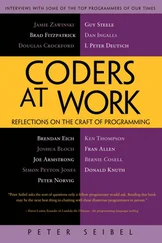Peter Siebel - Practical Common Lisp
Здесь есть возможность читать онлайн «Peter Siebel - Practical Common Lisp» весь текст электронной книги совершенно бесплатно (целиком полную версию без сокращений). В некоторых случаях можно слушать аудио, скачать через торрент в формате fb2 и присутствует краткое содержание. Год выпуска: 2005, ISBN: 2005, Издательство: Apress, Жанр: Программирование, на английском языке. Описание произведения, (предисловие) а так же отзывы посетителей доступны на портале библиотеки ЛибКат.
- Название:Practical Common Lisp
- Автор:
- Издательство:Apress
- Жанр:
- Год:2005
- ISBN:1-59059-239-5
- Рейтинг книги:4 / 5. Голосов: 1
-
Избранное:Добавить в избранное
- Отзывы:
-
Ваша оценка:
- 80
- 1
- 2
- 3
- 4
- 5
Practical Common Lisp: краткое содержание, описание и аннотация
Предлагаем к чтению аннотацию, описание, краткое содержание или предисловие (зависит от того, что написал сам автор книги «Practical Common Lisp»). Если вы не нашли необходимую информацию о книге — напишите в комментариях, мы постараемся отыскать её.
Practical Common Lisp — читать онлайн бесплатно полную книгу (весь текст) целиком
Ниже представлен текст книги, разбитый по страницам. Система сохранения места последней прочитанной страницы, позволяет с удобством читать онлайн бесплатно книгу «Practical Common Lisp», без необходимости каждый раз заново искать на чём Вы остановились. Поставьте закладку, и сможете в любой момент перейти на страницу, на которой закончили чтение.
Интервал:
Закладка:
(make-cd
(prompt-read "Title")
(prompt-read "Artist")
(prompt-read "Rating")
(prompt-read "Ripped [y/n]")))
That's almost right. Except prompt-readreturns a string, which, while fine for the Title and Artist fields, isn't so great for the Rating and Ripped fields, which should be a number and a boolean. Depending on how sophisticated a user interface you want, you can go to arbitrary lengths to validate the data the user enters. For now let's lean toward the quick and dirty: you can wrap the prompt-readfor the rating in a call to Lisp's PARSE-INTEGER function, like this:
(parse-integer (prompt-read "Rating"))
Unfortunately, the default behavior of PARSE-INTEGER is to signal an error if it can't parse an integer out of the string or if there's any non-numeric junk in the string. However, it takes an optional keyword argument :junk-allowed, which tells it to relax a bit.
(parse-integer (prompt-read "Rating") :junk-allowed t)
But there's still one problem: if it can't find an integer amidst all the junk, PARSE-INTEGER will return NILrather than a number. In keeping with the quick-and-dirty approach, you may just want to call that 0 and continue. Lisp's OR macro is just the thing you need here. It's similar to the "short-circuiting" ||in Perl, Python, Java, and C; it takes a series of expressions, evaluates them one at a time, and returns the first non-nil value (or NIL if they're all NIL ). So you can use the following:
(or (parse-integer (prompt-read "Rating") :junk-allowed t) 0)
to get a default value of 0.
Fixing the code to prompt for Ripped is quite a bit simpler. You can just use the Common Lisp function Y-OR-N-P .
(y-or-n-p "Ripped [y/n]: ")
In fact, this will be the most robust part of prompt-for-cd, as Y-OR-N-P will reprompt the user if they enter something that doesn't start with y , Y , n , or N .
Putting those pieces together you get a reasonably robust prompt-for-cdfunction.
(defun prompt-for-cd ()
(make-cd
(prompt-read "Title")
(prompt-read "Artist")
(or (parse-integer (prompt-read "Rating") :junk-allowed t) 0)
(y-or-n-p "Ripped [y/n]: ")))
Finally, you can finish the "add a bunch of CDs" interface by wrapping prompt-for-cdin a function that loops until the user is done. You can use the simple form of the LOOP macro, which repeatedly executes a body of expressions until it's exited by a call to RETURN . For example:
(defun add-cds ()
(loop (add-record (prompt-for-cd))
(if (not (y-or-n-p "Another? [y/n]: ")) (return))))
Now you can use add-cdsto add some more CDs to the database.
CL-USER> (add-cds)
Title: Rockin' the Suburbs
Artist: Ben Folds
Rating: 6
Ripped [y/n]: y
Another? [y/n]: y
Title: Give Us a Break
Artist: Limpopo
Rating: 10
Ripped [y/n]: y
Another? [y/n]: y
Title: Lyle Lovett
Artist: Lyle Lovett
Rating: 9
Ripped [y/n]: y
Another? [y/n]: n
NIL
Saving and Loading the Database
Having a convenient way to add records to the database is nice. But it's not so nice that the user is going to be very happy if they have to reenter all the records every time they quit and restart Lisp. Luckily, with the data structures you're using to represent the data, it's trivially easy to save the data to a file and reload it later. Here's a save-dbfunction that takes a filename as an argument and saves the current state of the database:
(defun save-db (filename)
(with-open-file (out filename
:direction :output
:if-exists :supersede)
(with-standard-io-syntax
(print *db* out))))
The WITH-OPEN-FILE macro opens a file, binds the stream to a variable, executes a set of expressions, and then closes the file. It also makes sure the file is closed even if something goes wrong while evaluating the body. The list directly after WITH-OPEN-FILE isn't a function call but rather part of the syntax defined by WITH-OPEN-FILE . It contains the name of the variable that will hold the file stream to which you'll write within the body of WITH-OPEN-FILE , a value that must be a file name, and then some options that control how the file is opened. Here you specify that you're opening the file for writing with :direction :outputand that you want to overwrite an existing file of the same name if it exists with :if-exists :supersede.
Once you have the file open, all you have to do is print the contents of the database with (print *db* out). Unlike FORMAT , PRINT prints Lisp objects in a form that can be read back in by the Lisp reader. The macro WITH-STANDARD-IO-SYNTAX ensures that certain variables that affect the behavior of PRINT are set to their standard values. You'll use the same macro when you read the data back in to make sure the Lisp reader and printer are operating compatibly.
The argument to save-dbshould be a string containing the name of the file where the user wants to save the database. The exact form of the string will depend on what operating system they're using. For instance, on a Unix box they should be able to call save-dblike this:
CL-USER> (save-db "~/my-cds.db")
((:TITLE "Lyle Lovett" :ARTIST "Lyle Lovett" :RATING 9 :RIPPED T)
(:TITLE "Give Us a Break" :ARTIST "Limpopo" :RATING 10 :RIPPED T)
(:TITLE "Rockin' the Suburbs" :ARTIST "Ben Folds" :RATING 6 :RIPPED
T)
(:TITLE "Home" :ARTIST "Dixie Chicks" :RATING 9 :RIPPED T)
(:TITLE "Fly" :ARTIST "Dixie Chicks" :RATING 8 :RIPPED T)
(:TITLE "Roses" :ARTIST "Kathy Mattea" :RATING 9 :RIPPED T))
On Windows, the filename might be something like " c:/my-cds.db" or " c:\\my-cds.db." [27] Windows actually understands forward slashes in filenames even though it normally uses a backslash as the directory separator. This is convenient since otherwise you have to write double backslashes because backslash is the escape character in Lisp strings.
You can open this file in any text editor to see what it looks like. You should see something a lot like what the REPL prints if you type *db*.
The function to load the database back in is similar.
(defun load-db (filename)
(with-open-file (in filename)
(with-standard-io-syntax
(setf *db* (read in)))))
This time you don't need to specify :directionin the options to WITH-OPEN-FILE , since you want the default of :input. And instead of printing, you use the function READ to read from the stream in. This is the same reader used by the REPL and can read any Lisp expression you could type at the REPL prompt. However, in this case, you're just reading and saving the expression, not evaluating it. Again, the WITH-STANDARD-IO-SYNTAX macro ensures that READ is using the same basic syntax that save-dbdid when it PRINT ed the data.
Интервал:
Закладка:
Похожие книги на «Practical Common Lisp»
Представляем Вашему вниманию похожие книги на «Practical Common Lisp» списком для выбора. Мы отобрали схожую по названию и смыслу литературу в надежде предоставить читателям больше вариантов отыскать новые, интересные, ещё непрочитанные произведения.
Обсуждение, отзывы о книге «Practical Common Lisp» и просто собственные мнения читателей. Оставьте ваши комментарии, напишите, что Вы думаете о произведении, его смысле или главных героях. Укажите что конкретно понравилось, а что нет, и почему Вы так считаете.








